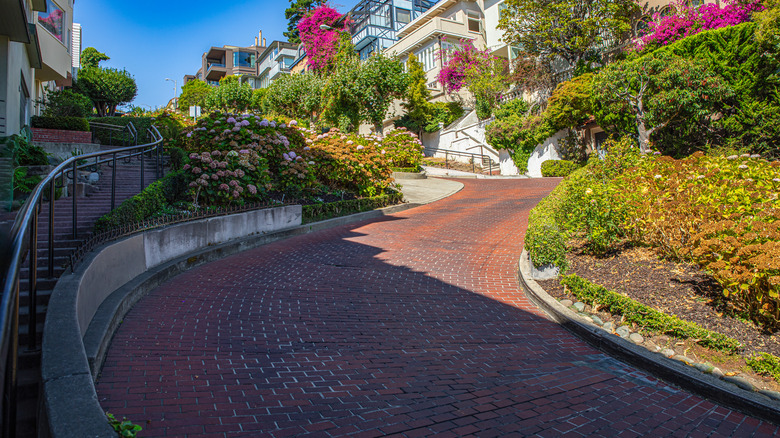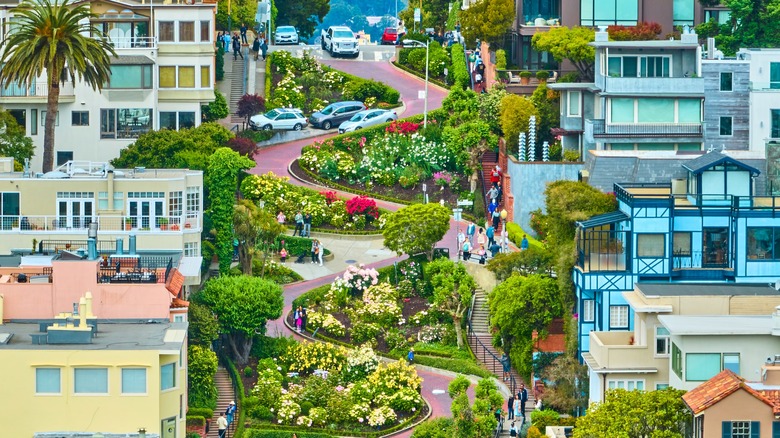San Francisco's Most Bizarre Street Is Actually A Brilliant Bit Of Design
Visitors to the famous City By The Bay will naturally want to take in some of the best known tourist sights, like the infamous Alcatraz and the Golden Gate Bridge. However, there's another more residential location that lots of tourists also flock to: Lombard Street. Visitors have some weird Californian traffic laws to be aware of, but also some remarkable sights to see. The thing that's so unique about Lombard Street, as you may know, is its curved design. This is a regular street in the city, located in between the streets of Leavenworth and Hyde. One area of it sports that legendary series of hair-raising hairpin bends. It's become a huge tourist attraction with over two million visitors every year, and it's little wonder why: Its uniqueness, coupled with the sheer beauty of the area, is one of those things that photographs just don't do justice to.
Lombard Street looks as though it's simply designed to attract attention and tourists. It has a real wow factor. Its visual appeal aside, though, the street's design is eminently practical. It was designed in this way mostly for safety's sake, because, when simply straight, its long, sloping angle made it very difficult and dangerous to traverse. It was so steep, in fact, that a total of eight of these bends were needed in order to tame the slope for local residents and their vehicles. Local property owner Carl Henry is said to have had the idea for this street design in the 1920s, with Clyde Healy, city engineer, spearheading the efforts to make it happen. Offering safer passage while ensuring that local properties could be accessed by car (at a crucial time in the developing popularity of the auto) was the aim, and it was achieved in style.
The history of Lombard Street's wonderfully crooked design
When Lombard Street was first developed into the curvy route, it was the logical route to take. Local properties were taking a hit to their value because cars were out of the question there, and, as ever, financial matters were a priority. It was all about the safety and other concerns of the local community, as should be prioritized in a residential area. It was some decades later, in the 1960s, that the characteristic hydrangeas were added. This additional splash of stunning color saw Lombard Street begin to take on the additional dimension of a tourist spot worth visiting on its own merits.
Unfortunately, though, this meant rising crowd numbers and potential disruption for residents. In January 2019, the Los Angeles Times reported that local authorities were considering limiting numbers of vehicles passing through to up to 4,800 per day, and charging a fee of up to $10 for tourists to drive this legendary street themselves. It's a mark of just how unique and stunning this street is that, in a city full of world-famous landmarks, it's just that popular. Ultimately, the charge to use the road was never implemented, so it's still free to enjoy. The key is to be courteous to those who call Lombard Street their home while doing so.
Other unusual San Francisco roads
In the United States, in particular, there's a real fascination with attractions that claim to be the world's biggest, longest, or tallest such-and-such. A road trip isn't complete without some game changing-gadgets or without a visit to, say, the world's largest thermometer (it's in Baker in California, incidentally). The crux of Lombard Street's popularity, then, is that it's renowned as the world's most crooked road. Guinness World Records, declaring it to be so, adds, "only a 400-m (1/4-mile) long section of Lombard Street, as it descends a 27% incline, can claim so many hairpin turns in such a short distance – a total of 1,440 degrees twisted and turned in only 400 m."
This isn't to say, of course, that there aren't other roads in the world that may rival Lombard Street for its curved splendor. Elsewhere in San Francisco, Vermont Street stretches and winds in a similar fashion. As Guinness World Records states, though, Vermont Street's bends are more spread out, giving it a distinct identity of its own. Unfortunately, it also lacks the distinctive colorful brickwork that has helped to make Lombard an internationally recognized tourist spot. With its famous curves, it's a one-way stretch with a strict 5 mph speed limit. It's not the most conventional driving experience, and it's super busy to boot, but at least that won't be anything new. San Francisco, after all, is known for its awful traffic.


